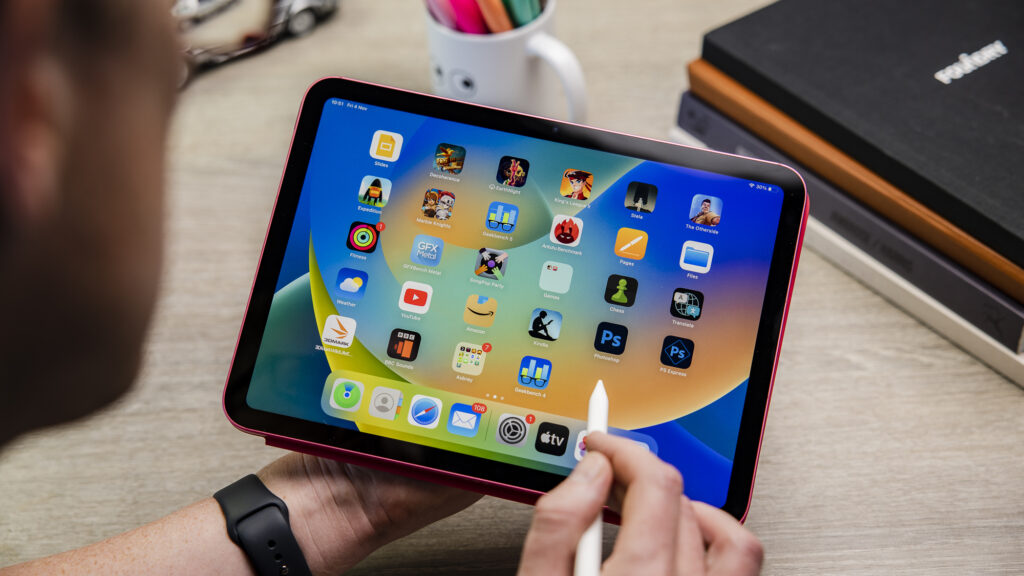Best iPad for seniors 2024

If you’re an older user looking to pick up an iPad or someone wanting to gift an Apple tablet to Grandad or Grandma, which is the best iPad to choose? There’s a fair selection in the current Apple catalog, from the diminutive iPad mini all the way up to the incredibly powerful (not to mention very expensive) iPad Pro. It can be intimidating, especially as different users have different needs. To help you make sense of it all, here’s our guide to finding the best iPad for seniors.
What makes an iPad good for older users?
iPad owners don’t magically transform into timid technophobes on their 70th birthdays, and there isn’t one right answer to this question. Any iPad model might turn out to be the right choice for a specific older user, depending on that user’s precise requirements.
But there are a few criteria that tend to become more of a factor when our bodies begin to age. Screen size is one element, with eyes not being as strong as they once were. Weight/portability can also become more important; some older users have arthritis, while others find they tire more easily than they used to when using a tablet for extended periods of time.
We will also want to think carefully about price versus power and features, since you don’t want to spend lots of money on a device with capabilities you’ll never really use.
But, as we say, these can be true for any user, so it’s always best to talk to the person in question about their particular needs if you want to pick the perfect tablet.
If you were to put us on the spot, however, we do have some thoughts about the iPads that are most likely to suit an older user. Here’s our selection.
Best affordable option: iPad (2022, 10th generation)
Pros
Affordable
A14 Bionic processor
Support for Apple Pencil (USB and 1st Gen)
Solid performance
Cons
No Home button
Base 64GB storage is quite low
Price When Reviewed:
From $349 (64GB) | $499 (256GB) (was $449 and $599)
At $349, the 10th-gen iPad may well be the cheapest iPad model in Apple’s current lineup, but that doesn’t mean it’s a truly ‘budget’ device in the pejorative sense. For many (perhaps most) people, this iPad will deliver everything you want from a tablet and not cost you a small fortune in the process.
Apple’s A14 Bionic chip powers the iPad and it’s ideal for surfing the web, watching streaming services, and shopping online. It’s an older processor–Apple is using more-recent M-series chips in the more-expensive iPad Air and iPad Pro, but it’s a chip that should be supported by Apple for a few more years.
For FaceTime calls there’s a 12MP Ultra Wide front camera that offers advanced features such as Center Stage (which allows you to move around on video calls while the iPad tracks you so you don’t disappear out of view) and 1080p video. This iPad was the first to place the camera on the longer side of the iPad, so when you use it, the iPad should be in landscape mode.
Why are these features particularly good for seniors? Well, having an excellent video-call experience will allow them to keep in touch with the grandkids, friends or family around the world, without looking grainy or like they’re calling from the early 2000s.
The 10.9-inch display is also large enough for eyes that might be starting to diminish, while the touch targets on the screen will be easy to hit with unsteady hands. Of course, many seniors are full of more life and vigor than their grandchildren, and the ability to connect an Apple Smart keyboard and first-gen Apple Pencil makes this a perfect companion for traveling while writing memoirs or creating art. It’s also the only remaining iPad to feature a headphone jack, which could be very useful if the intended recipient hasn’t yet embraced the wireless charms of the AirPods or AirPod Pros.
Another major change Apple made with the 10th-gen iPad (in addition to moving the front-facing camera) is that it no longer has a Home button. iPadOS features many great swipe gestures for navigating through apps and menus, and to get to the Home screen, you swipe up from the bottom center of the display. Touch ID is now located on the power button.
The 10th-gen iPad comes in these storage options, priced as follows:
64GB: $349/£349
256GB: $499/£499
If you want to add cellular capabilities then those are also available:
64GB (cellular): $499/£499
256GB (cellular): $649/£649
It isn’t just the best choice for older users, but probably for most users.
If you prefer an iPad with a Home button, you can probably find a 9th-generation iPad, which is the last one with a Home button, You may be able to find stock at a third-party retailer. Apple sells refurbished iPads in its Certified Refurbished Store (U.S. or U.K.) but the inventory availability fluctuates a lot, so it may not be in stock when you check. Be sure to check back at a later time.
Read our full
10th-gen 10.9-inch iPad (2022) review
Best lightweight option: iPad mini (A17 Pro)
Pros
Lightweight
Modern design
A17 Pro processor
Cons
Smaller screen size
128GB storage on base model
Price When Reviewed:
$499 (128GB; Wi-Fi only) | $599 (256GB; Wi-Fi only) | $799 (512GB; Wi-Fi only)
It’s a sad fact that as we age our bodies can lose some of their strength or gain some conditions that we avoided when younger. If you’re looking for a lightweight iPad, and therefore easier to hold for longer periods, then the iPad mini (A17 Pro) is the one to choose. At around 0.65lbs/293g it’s roughly half the weight of the 10th gen iPad discussed above.
This is made possible, as the name suggests, by the smaller display. But the 8.3-inch panel is still an excellent size for the web, not to mention better as an e-reader thanks to being easier to hold.
Under the hood, the iPad mini is a powerhouse, with an A17 Pro chip (as seen in the iPhone 15 Pro), 5G capabilities on the LTE models, and powerful cameras with the same Ultra Wide front-facing module as on the 10th-gen iPad. It’s compatible with the Apple Pencil (USB-C) and the Apple Pencil Pro and various Bluetooth keyboards, so you can use it like a small laptop if you want to get stuff done.
It’s a lovely package that offers the most portable solution for those who want to take their iPad with them.
The iPad mini (A17 Pro) is available in these configurations:
iPad mini (A17 Pro, Wi-Fi) 128GB: $499/£499
iPad mini (A17 Pro, Wi-Fi) 256GB: $599/£599
iPad mini (A17 Pro, Wi-Fi) 512GB: $799/£799
iPad mini (A17 Pro, Wi-Fi + cellular) 128GB: $649/£649
iPad mini (A17 Pro, Wi-Fi + cellular) 256GB: $749/£749
iPad mini (A17 Pro, Wi-Fi + cellular) 512GB: $949/£949
Check our guide to the best iPad mini deals to see if you can get one for a lower price.
Read our full
Apple iPad mini (A17 Pro) review
Best all-rounder: iPad (2022, 10th generation)
Pros
10.9-inch Liquid Retina Display
Modern design
Landscape camera
Various colors
USB-C port
Cons
Higher price than previous generations
64GB of storage on base modell
Price When Reviewed:
From $449
The newest device on this list is the 10th generation iPad, which arrived in October 2022 without the Home button design of its forebears and follows the aesthetic established by iPad mini and iPad Air. Although the Home button is gone, this iPad still features Touch ID, it’s just that the sensor is now part of the power button that resides on the top edge of the device. This allows Apple to fit a large 10.9-inch Liquid Retina Display into a chassis that’s almost the same size as the 9th generation iPad, which has a 10.2-inch screen. This increased screen real estate will be attractive to those who prefer larger fonts and should make tapping on-screen buttons a little easier for unsteady hands.
One of the main new features, aside from the overall design, is that Apple has finally moved the front-facing camera from the traditional top bezel to the longer side one. This essentially turns it from portrait to landscape, hence the name Landscape Ultra Wide camera. The upside of this is that you can sit the iPad on its longer side when making FaceTime calls, which will have you looking into the middle of the camera rather than it being off to the side. There’s also support for Centre-Stage, so if you move around, the software will keep you in the center of the shot. This makes it the best iPad for FaceTime calls with family.
The included A14 Bionic chip, which previously powered the iPhone 12 range (including the Pro models), means there’s plenty of performance available for most. You can use the 1st generation Apple Pencil on this device, and the new USB-C port opens up a world of peripherals you can plug into the iPad. These include keyboards, external storage, and even monitors if you want a pseudo-desktop PC.
One drawback of this switch is that owners of a 1st generation Apple Pencil will need to buy an adaptor to be able to charge it from the iPad. If you buy a new Pencil from Apple, the adapter is now included in the box.
The iPad comes in four attractive colors (Blue, Pink, Yellow, and Silver).
These are the available configurations:
64GB: $349/£349
256GB: $499/£499
64GB (cellular): $499/£499
256GB (cellular): $649/£649
As with the other iPads on this list, you might want to consider opting for the 256GB storage variant, as 64GB can fill up pretty quickly if you like to store photos and videos on the device itself. Apple also offers a new keyboard case called the Magic Keyboard Folio, which is nice but costs an eye-watering $249/£279, so we’d advise looking for cheaper (and often just as good) third-party products instead. See our iPad keyboard roundup.
Like the iPad mini the iPad may also get an update in 2024.
For more information, take a look at our Everything you need to know about the iPad 10.9-inch (10th Generation) guide.
Best performance option: 11-inch iPad Air (2024)
Pros
M2 processor
USB-C port
Apple Pencil (2nd Gen) support
Smart connector
Cons
Getting expensive
Price When Reviewed:
$599 (128GB, Wi-Fi only)
While it’s true that the iPad Pro models are the most powerful iPads available, for most people they are simply overkill. Also, they come with Pro-level prices, which isn’t great if you’re only going to use them to watch videos and FaceTime the grandkids. For the more discerning user who requires plenty of power but at a reasonable price, the iPad Air is an excellent solution.
There’s not much to differentiate the 10th-gen iPad and the 11-inch iPad Air. but, when you look closely, you can see from where the extra expense comes. The two devices are around the same size, and both sport a Liquid Retina display, but the one on the Air is fully-laminated, so there’s no air-gap between the glass and digitizer, which makes it feel like you’re touching the actual pixels and makes using the compatible Apple Pencil (2nd gen) that much smoother.
They feature the same 12MP cameras on the back and front on the longer side of the device. But, under the hood the Air has the incredibly powerful M2 processor, which was previously found in the last generation of iPad Pros, not to mention several recent Macs. This takes things to another level. If someone wants to play games, use graphically intensive apps or just wants a really fast user experience, then the M2 delivers that in spades.
The iPad Air has often been called the iPad Pro for normal people, and that’s exactly what it is. The USB-C port allows you to connect various external devices, such as storage or monitors, so it can easily transform into a laptop with a processor that’s desktop-class. Apple offers the sleek Magic Keyboard folio case, but at $299/£319 it’s way overpriced, so we’d suggest a third-party Bluetooth keyboard and case as a more frugal option.
The iPad Air base configuration has 128GB of storage, twice that of the base 10th-gen iPad. That should be plenty for most people; you can rely on iCloud storage if you’re worried that you’ll run out of space. You can also go with the more expensive 256GB configuration.
You can pick up the 11-inch iPad Air in the following configurations:
iPad Air (2024, Wi-Fi) 128GB: $599/£599
iPad Air (2024, Wi-Fi) 256GB: $699/£699
iPad Air (2024, Wi-Fi) 512GB: $899/£899
iPad Air (2024, Wi-Fi) 1TB: $1,099/£1,099
iPad Air (2024, Wi-Fi + Cellular) 128GB: $749/£749
iPad Air (2024, Wi-Fi + Cellular) 256GB: $849/£849
iPad Air (2024, Wi-Fi + Cellular) 512GB: $1,049/£1,049
iPad Air (2024, Wi-Fi + Cellular) 1TB: $1,249/£1,249
Also read our roundup of the best iPad Air deals too, so you don’t miss out on any great offers.
Read our full
Apple iPad Air 11-inch (M2, 2024) review
Best luxury option: iPad Pro (2024)
Pros
Insanely powerful
Best iPads money can buy
ProMotion displays
Cons
Very expensive
Too much power for most people
Price When Reviewed:
$999 (Wi-Fi only)
For those to whom money is no object or require the highest-end performance an iPad can deliver, the iPad Pro is the only choice. Recently upgraded to the latest M4 processor, these are devices that absolutely fly. Every appointment is top-notch, from the Ultra Retina XDR display with super-smooth ProMotion technology to the USB-C ports that support Thunderbolt 4. These are Pro devices. With that is the caveat that most people won’t necessarily see these benefits unless they are using pro-level apps that push the device hard.
The Pro comes in two sizes, 11-inch and 13-inch, with the latter being an absolute whopper. If you need a large screen then this is as big as it gets. Apple offers a 13-inch iPAd Air that’s cheaper, but its screen isn’t as nice as the Pro, and the Air is actually heavier than the Pro. (Go figure.)
To anyone other than a professional designer, animator, or digital specialist who can harness the power of the iPad Pros, these are simply too much and your money would be better spent on the iPad Air. But, if that’s you or you just want a luxury iPad to enjoy, then this is the premium end of the street.
The iPad Pro 11-inch (2024) is available in the following configurations:
256GB: $999/£999
512GB: $1,199/£1,199
1TB: $1,599/£1,599
2TB: $1,999/£1,999
If you want 5G cellular capabilities, then these are the options:
256GB (Cellular): $1,199/£1,199
512GB (Cellular): $1,399/£1,399
1TB (Cellular): $1,799/£1,799
2TB (Cellular): $2,199/£2,199
The iPad Pro 13-inch (2024) is available in these configurations:
256GB: $1,299/£1,299
512GB: $1,499/£1,499
1TB: $1,899/£1,899
2TB: $2,299/£2,299
Here are the prices for the cellular-equipped models:
256GB (Cellular): $1,499/£1,499
512GB (Cellular): $1,699/£1,699
1TB (Cellular): $2,099/£2,099
2TB (Cellular): $2,499/£2,499
Check out our roundup of the best iPad Pro deals to see if you can get a good bargain on these flagship devices. For more about how the iPad Pro and iPad Air compare read iPad Air (M2) vs iPad Pro (M4).
Read our full
Apple iPad Pro 11-inch (M4, 2024) review



